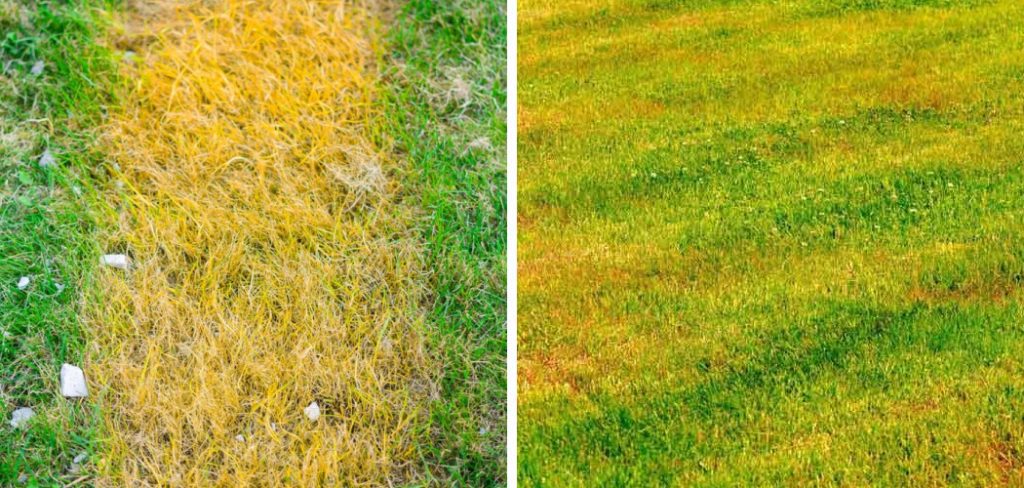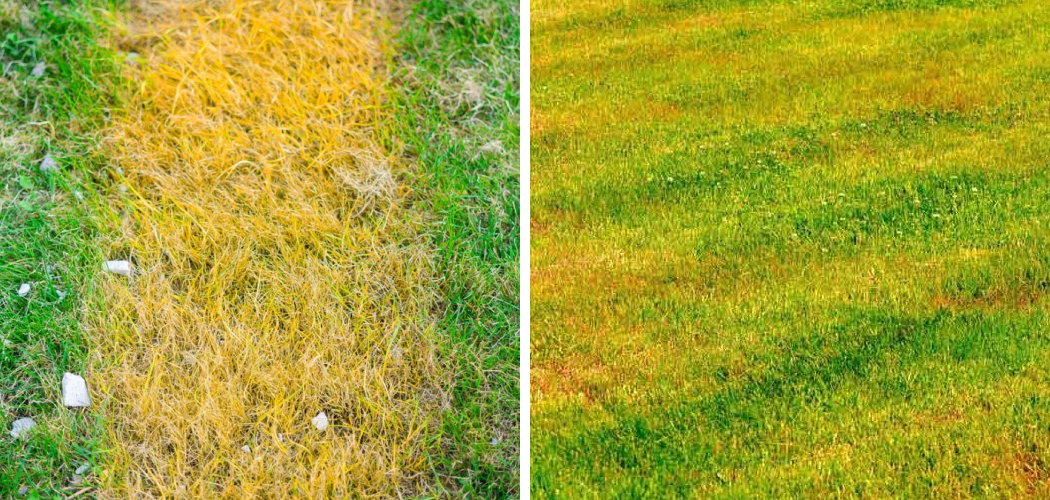To fix yellow grass after mowing, address underlying issues like improper watering, nutrient deficiencies, or fungal infections. Implement proper watering and fertilization techniques, and consider using fungicides if necessary.
Additionally, practice regular lawn maintenance, such as proper mowing height and frequency, to promote healthy grass growth and prevent further yellowing. Maintaining a lush and vibrant lawn can be a challenging task, especially when unsightly yellow patches start to appear after mowing.
These discolored areas are not only unattractive but may also indicate underlying issues affecting the health of your grass. However, with a few simple steps, you can effectively address the problem and restore your lawn’s natural green beauty. We will explore the causes of yellow grass after mowing and provide practical solutions to fix and prevent this issue. By understanding the underlying factors and implementing proper lawn care practices, you’ll be able to enjoy a healthy, green lawn that enhances the beauty of your outdoor space. So, let’s dive in and learn how to fix yellow grass after mowing!

Common Causes Of Yellow Grass After Mowing
Yellow grass after mowing is a common problem that can be caused by different factors. One possible cause is overfertilization, where excessive amounts of fertilizer are applied to the grass, leading to burns and discoloration. Another reason could be improper mowing techniques, such as cutting the grass too short or using dull blades, which can stress the grass and cause it to turn yellow.
Additionally, yellow grass can be a sign of disease or pest infestation, such as fungal infections or insect damage. To fix yellow grass, it is important to identify the root cause and address it accordingly. This may involve adjusting fertilization practices, improving mowing techniques, or applying appropriate treatments to address diseases or pests.
Taking proper care of your lawn, including regular watering, aerating, and feeding, can also help prevent yellow grass after mowing.
Assessing The Health Of Your Lawn
Grass turning yellow after mowing can be an indication of various problems affecting lawn health. To identify the extent of the yellowing, closely inspect the affected area. Look for signs of pests or diseases like discoloration, chewed leaves, or unusual growth patterns.
Additionally, check the soil condition by assessing its moisture levels, compaction, and ph. Testing the soil can provide valuable insights into nutrient deficiencies or imbalances that may be causing the yellow grass. Once you have assessed the health of your lawn, take appropriate steps to address the identified issues.
This may involve adjusting watering or fertilization practices, removing pests or treating diseases, and improving soil quality through aeration or amendment. By addressing these factors, you can restore the vibrancy and greenness of your lawn, eliminating the yellow grass problem.
How to Fix Yellow Grass After Mowing: Step by Step Guide
1. Adjusting Mowing Techniques
When it comes to fixing yellow grass after mowing, adjusting mowing techniques is essential. Cutting the grass at the proper height is one important guideline to follow. Using sharp and clean blades is another crucial factor. It’s also important to avoid mowing in extreme weather conditions.
By adhering to these guidelines, you can effectively address the issue of yellow grass after mowing. Remember, the key is to adjust your mowing techniques, maintain the right height, and ensure the blades are sharp and clean. Additionally, avoid mowing when the weather is extreme, as this can further harm the grass.
Taking these steps will help you restore a healthy, green lawn. Keep these tips in mind for a vibrant and attractive lawn all year round.
2. Correcting Overfertilization
Understanding proper fertilization schedules is crucial to fixing yellow grass after mowing. Overfertilization can cause discoloration. To correct this issue, dilute excess fertilizer with water. This will help lessen the concentration and prevent further damage. Additionally, consider using organic fertilizers for better long-term results.
These types of fertilizers are gentler on the grass and promote overall health. By adhering to the right fertilization schedule and making adjustments as necessary, you can quickly restore the vibrancy of your lawn. Get rid of yellow grass by correcting overfertilization for a lush, green landscape.
3. Treating Lawn Diseases And Pests
Yellow grass is a common problem after mowing, but it can be fixed easily. One way to tackle lawn diseases and pests is by identifying their symptoms. By doing so, you can apply the appropriate fungicides or insecticides to treat the problem.
Another important aspect is maintaining a regular lawn care routine to prevent future issues. By taking care of your lawn regularly, you can keep it healthy and avoid yellow grass. So, if you notice any signs of lawn diseases or pests, take immediate action to restore your grass’s vibrant green color and maintain a beautiful lawn all year round.
4. Enhancing Soil Health
Testing soil ph and nutrient levels is the first step in enhancing soil health. Correcting soil compaction and drainage issues should also be prioritized. To further improve soil quality, amend it with organic matter and nutrients. By doing so, yellow grass after mowing can be fixed effectively.
By addressing these soil-related factors, the grass will receive the necessary nutrients and water it needs to thrive. This will result in healthy and green grass that enhances the overall appearance of your lawn. So, ensure you regularly test and optimize soil conditions to keep your grass looking vibrant and fresh throughout the year.
With proper care, your lawn can be a source of pride and beauty in your home.
Establishing A Proper Lawn Care Routine
Establishing a proper lawn care routine is essential for fixing yellow grass after mowing. Regular watering and proper irrigation techniques contribute to healthier and greener grass. Adequate hydration is crucial for the grass’s growth and helps prevent the yellowing. Aeration is a beneficial practice as it improves oxygen and water penetration into the soil, enabling nutrients to reach the grass roots.
By regularly aerating the lawn, you can revive the yellow patches. Another effective method is seeding and overseeding, which helps in achieving a thick and dense lawn. Planting new grass seeds in the damaged areas can fill in the yellow spots and promote uniformity.
Implementing these strategies will rejuvenate your lawn and restore its vibrant green color.
Preventive Measures For Yellow Grass
To fix yellow grass after mowing, it is important to take preventive measures. Avoid excessive foot traffic on the grass to prevent damage. Implement proper weed control strategies to ensure a healthy lawn. Regularly monitor and detect any early signs of lawn issues to address them promptly.
By following these guidelines, you can maintain a vibrant and lush green lawn.
Seeking Professional Help
To fix yellow grass after mowing, consider seeking professional help from a reliable lawn care service. Consulting with turf management experts can provide valuable guidance for maintaining long-term lawn health. By engaging professionals, you can benefit from their knowledge and experience in effectively addressing the issue.
They can offer insights on potential causes of yellow grass and recommend appropriate remedies to restore its vibrant green color. Furthermore, professional lawn care services often have access to specialized equipment and products that can help rejuvenate the grass. Taking this proactive step can save you time and effort, ensuring your lawn remains healthy and visually appealing.
Trusting experts to handle the task will give you peace of mind and allow you to enjoy a lush, vibrant lawn.
Frequently Asked Questions Of How To Fix Yellow Grass After Mowing
Why Does My Grass Turn Yellow After I Mow It?
Mowing can cause grass to turn yellow due to a few reasons. Firstly, mowing cuts off the top parts of the grass blades, which contain chlorophyll, the pigment responsible for the lush green color. Additionally, mowing can stress the grass, especially if it is cut too short.
The stress can inhibit the grass’s ability to absorb nutrients and water, resulting in yellowing. Another factor is that mowing can expose the lower, less sunlight-exposed parts of the grass, which may have a yellowish tint naturally. It is important to mow at the correct height, ensuring not to remove more than one-third of the grass blade’s height at a time.
Regular watering and fertilizing also help maintain a healthy, green lawn.
How Do You Revive Yellow Grass?
Reviving yellow grass requires proper watering, fertilization, aeration, and regular mowing. Ensure the grass receives about 1 inch of water per week, either from rainfall or irrigation. Use a slow-release nitrogen fertilizer to encourage healthy growth, following the instructions carefully.
Aerating the soil allows for better water and nutrient absorption. Mow the grass to a height of 2-3 inches, removing only one-third of the grass blade at a time. This prevents stress on the grass and encourages denser growth. Additionally, consider overseeding the lawn with a grass variety that thrives in your climate and soil conditions.
Avoid overwatering or using excessive fertilizer, as it can lead to more problems. By following these steps, yellow grass can be revived, restoring it to vibrant green.
Can You Reverse Yellow Grass?
Yes, yellow grass can be reversed. The main cause of yellow grass is lack of water, so proper watering is essential. Water the grass deeply and less frequently to promote deep root growth. Ensure that you water in the early morning or late evening to minimize evaporation.
Additionally, avoid over-fertilizing as this can contribute to yellowing. If the yellow grass is caused by nutrient deficiency, applying a nitrogen-rich fertilizer can help. It’s also important to address any underlying issues such as compacted soil or pest infestations. Aerating the soil and treating for pests can help restore the health of the grass.
By following these steps and implementing proper lawn care practices, the yellow grass can be reversed and your lawn can regain its lush green color.
Will Yellow Sod Turn Green Again?
Yes, yellow sod can turn green again. This can happen with proper care and treatment. It is important to identify the underlying cause of the yellowing, such as lack of water, nutrient deficiencies, or disease. Once identified, the issue can be addressed accordingly.
First, ensure the sod is receiving adequate water, adjusting watering schedule as needed. Secondly, apply a balanced fertilizer to supply essential nutrients. Additionally, consider aerating the soil to improve its health and promote root growth. Lastly, treat any diseases or pests that may be affecting the sod.
With time and proper care, the yellowing sod should gradually regain its green color. Remember to stay consistent with maintenance to prevent future discoloration and keep your lawn healthy and vibrant.
Conclusion
Maintaining a healthy and vibrant lawn often requires more than just regular mowing. Taking the necessary steps to fix yellow grass after mowing is essential for a visually appealing and thriving yard. First, make sure to adjust the cutting height of your mower to prevent cutting the grass too short, which can lead to stress and yellowing.
Secondly, ensure that you are mowing with sharp blades to achieve clean cuts that promote healthier growth. Additionally, regular watering and fertilizing can provide the necessary nutrients and hydration for your lawn to stay green and lush. Finally, addressing any underlying issues such as soil compaction or pest infestations can contribute to the overall health of the grass.
By implementing these measures, you can enjoy a vibrant and beautiful lawn year-round, free from yellow grass and other common problems.

